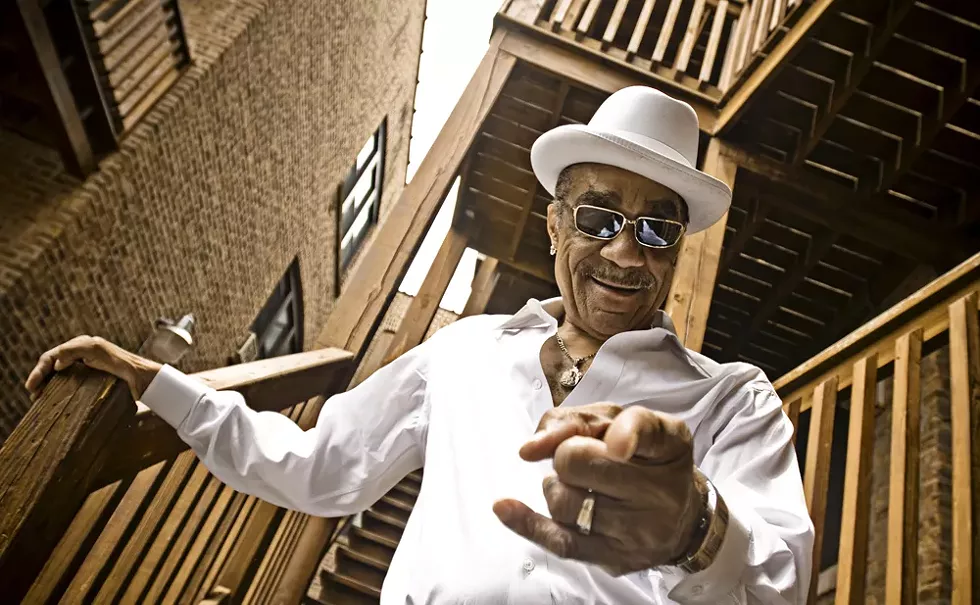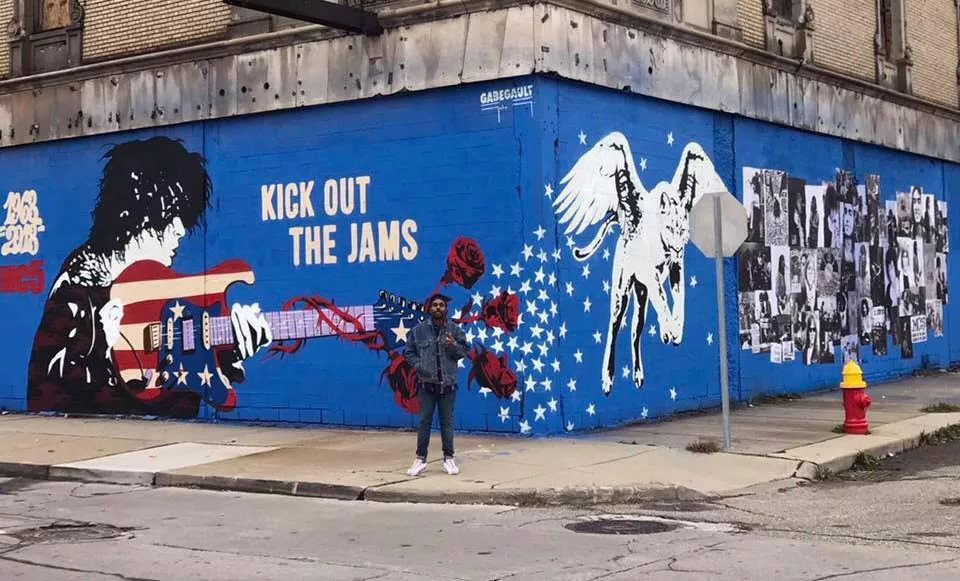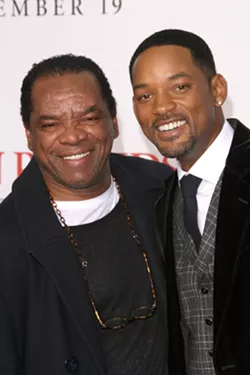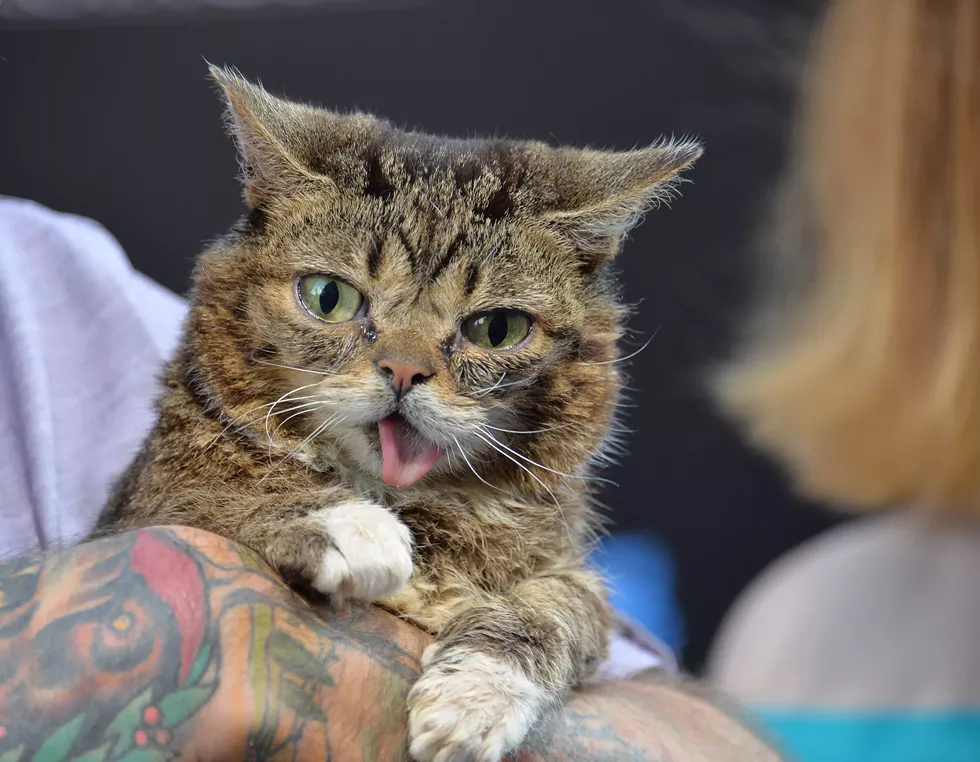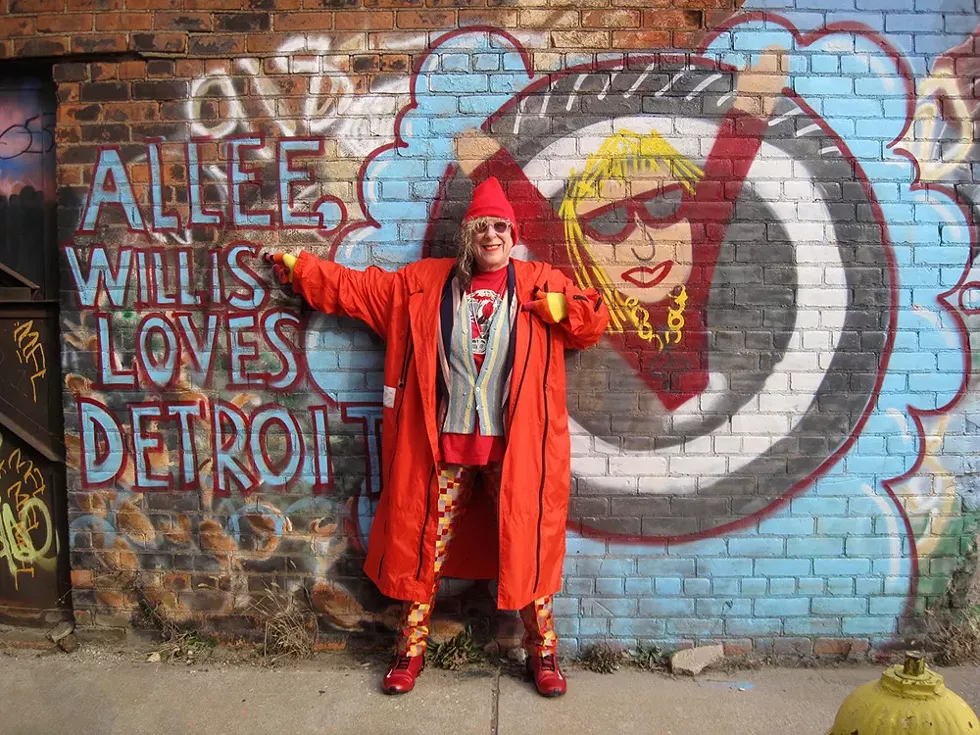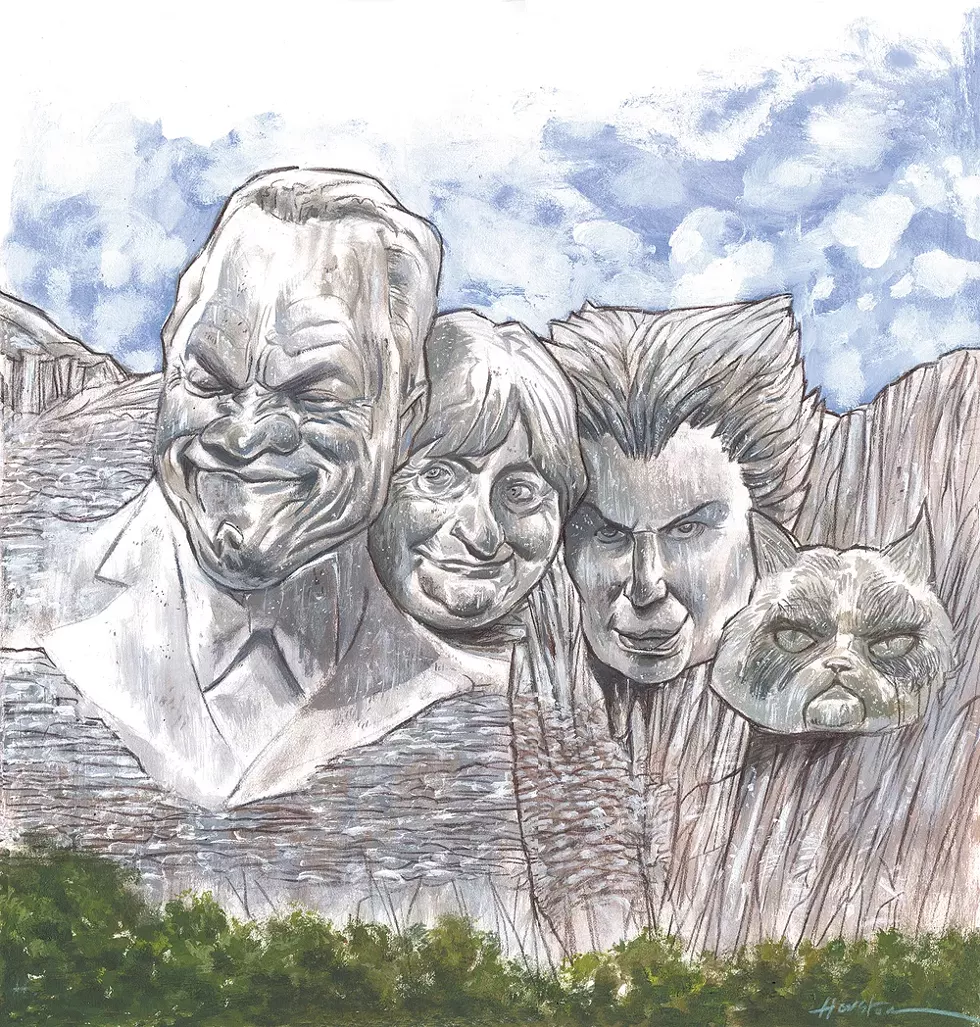
We all missed a lot this year. Too much happened, a decade's worth of chaos crammed into 12 months.
Among the scandals, battles, and Congressional hearings, some of the most interesting people — and internet cats — slipped away with too little time allotted to their deaths. That's why Metro Times has again teamed up with our sister papers in St. Louis, Cleveland, Orlando, San Antonio, Cincinnati, and Tampa to remember a fascinating few who made our world a little more intriguing.
Here you'll read of a conspiracy-juicing rock club owner, a stereotype-crushing astrologer, an unfairly maligned ballplayer, and the paint-by-numbers guy, among others. It's hard to say what 2020 will bring, but we're sorry these provocateurs, mold-breakers, and agitators won't be joining us there.
Olga Loizon, restaurateur
May 20, 1926–Jan. 21, 2019
Many metro Detroiters might not know Olga Loizon by name, but they probably know Olga's Kitchen, the restaurant chain she founded that's home of the Original Olga sandwich, Peasant Soup, Orange Cream Cooler, and perhaps most notably, the Snacker. Drawing inspiration from Greek souvlaki sandwiches (Loizon was a second-born daughter of Greek immigrants), Loizon started a modest restaurant operation in Birmingham in 1970 that was based almost entirely around her homemade pita bread. After a buyout, some expansion, franchising, and a name change, what she whipped up became a metro Detroit staple.
If at any point you visited a Michigan mall in the late '90s to early 2000s, chances are you were seduced by the scents of Olga's Kitchen— a seasoned symphony of "grilled to order" bread wrapped around a blend of lamb, beef, sweet onion, and tomato, and dripping in Olga sauce.
As a teenager growing up during what I believe were the death throes of mall rat culture, Olga's defied lunch table cliques — at least for me. If you shopped at Hot Topic, you ate at Olga's. If you fancied distressed, low-rise, boot-cut jeans from American Eagle, you ate at Olga's. Or, if you were like me and shopped primarily at thrift stores but would regrettably drop $50 on a sweatshop sweatshirt from PacSun or Gadzooks (remember Gadzooks?!) with a brand name plastered across it just to avoid a sideways glance on my way to English class, then you likely ate at Olga's. I know I did. A lot.
Who would have thought that a basket of tiny, triangle-shaped, elegantly seasoned fried-dough calorie bombs paired with a sweet and rich Swiss almond cheese (that was often served so cold that it would bend the Snacker upon dipping) could provide such a visceral teenage memory? A symbol of simpler times, perhaps? It was pre-Amazon, pre-smartphones. At the time, there was no greater pleasure than going to the mall unsupervised. Sitting across from my friend after her shift as an Olga's waitress, talking shit over curly fries, a hijacked Orange Cream Cooler, and some crazy, custom secret menu concoction the kitchen staff threw together, we, like Loizon, were dreamers. We knew what we wanted to do, but had no idea how to do it. We anguished over boy drama and curfews, scheming how to afford Blink-182 tickets. We were living in a pre-nightmare socio-political dystopian era. Fried bread was good enough to be great.
After filing for bankruptcy in 2015 and switching hands a few times, Olga's Kitchen made a move to exit several malls and invest in free-standing restaurants, while renovating others. While a short-lived downtown Detroit location shuttered amid the bankruptcy, a new location opened in Detroit's MGM Grand Detroit Casino this year. —Jerilyn Jordan
Ken Nordine, voice-over artist
April 13, 1920–Feb. 16, 2019
You might not know Ken Nordine's name, but chances are you've heard his voice.
Over the course of a 60-plus-year career, Nordine put the "art" into the concept of a voice-over artist. His silky baritone graced the airwaves of Chicago radio stations, narrating "The World's Great Novels" and other programs. He was also the voice behind several educational films, so if your teacher ever used a woefully out-of-date filmstrip in class, you might recognize his timbre. His most enduring creations, though, were his Word Jazz albums, on which, over backing tracks of cool jazz, Nordine tells stories or acts out scenarios with a particular focus on meter and sound.
Nordine's success with the Word Jazz series earned him a weekly program of the same name on flagship NPR station WBEZ in Chicago, and the show ended up running for more than 40 years. His 1967 Colors album, in which Nordine expounds upon the personalities of various hues, remains a favorite of those interested in offbeat curiosities from yesteryear. (It grew out of his radio commercials for the Fuller Paint Company.)
Lines from his recordings have been sampled in songs by Aesop Rock, Pizzicato Five, and the Orb, and in 2007, David Bowie Himself asked Nordine to perform at the High Line Festival in New York. —Thaddeus McCollum
Andre Williams, R&B singer
Nov. 1, 1936–March 17, 2019
Not many people get a big break in the music business. Andre Williams got two.
Born in Bessemer, Alabama, Zephire "Andre" Williams first hit it big as an R&B singer when he moved to Detroit in the early 1950s and won an Amateur Night competition. He soon signed to Fortune Records, becoming lead vocalist of the Five Dollars, later rechristened as Andre Williams and the Don Juans. A prolific writer, Williams also scored solo hits, including "Jail Bait," "The Greasy Chicken," and "Bacon Fat," which cracked the top 10 on the Billboard R&B chart. He also wrote the Five Du-Tones' "Shake a Tail Feather," later performed by Ike & Tina Turner (and much later, featured in The Blues Brothers and Hairspray), and even served a brief stint as a songwriter for Motown, co-writing Stevie Wonder's first song, "Thank You for Loving Me."
But by the 1980s, Williams hit rock bottom: Addiction found him homeless in Chicago. In the 1990s, however, Williams was rediscovered by the rock 'n' roll revival scene. That led to records like Greasy, released jointly on indie labels Norton and St. George Records in 1996, and Silky, released on In the Red in 1998. More indie rock collaborations followed, with Williams recording tracks with Jack White, Mick Collins of the Dirtbombs, and the country band the Sadies. His proto-hip-hop sing-talking style, penchant for profane lyrics, and sartorial preference for flashy suits and matching hats earned him the nickname by some of "the godfather of rap."
Williams continued to struggle with addiction, but he also continued to make music, releasing I Wanna Go Back to Detroit City in 2016. He died in Chicago from cancer, but he never stopped. His manager, Kenn Goodman, told Billboard a week before his death that the singer "was committed to trying to sing and record again." —Lee DeVito
Scott Walker, avant-garde musician
Jan. 9, 1943–March 22, 2019
How could one craft an appropriate epigraph to sum up the singular musical life of Scott Walker? Can you imagine Frank Sinatra in his later years collaborating with a doom-metal band? Or Justin Timberlake chucking away stardom for cigarettes, sunglasses, Bertolt Brecht, and slabs of raw meat as percussion instruments? Walker did it his way, and then some.
Fresh from a stint as a teenage session musician in L.A., Walker (né Noel Scott Engel in Hamilton, Ohio) became one-third of the Walker Brothers in the mid-1960s; they became immediate sensations in the U.K., mixing beat-combo moves with symphonic grandeur, yielding hits like "Make It Easy on Yourself" and the immortal "The Sun Ain't Gonna Shine Anymore." Soon enough, Walker found that screaming fans and the pop life weren't for him, at one point apocryphally retreating to a monastery to get his head together before being ejected by the monks as fans besieged the gates.
Walker struck out on his own, and from 1967-1969 crafted four of the most exquisite and heartbreaking albums of all time, the eponymous Scotts 1 through 4. This was Walker at his most iconic: sunglasses, shag haircut, and a soaring, unbelievably gorgeous voice offering no hope whatsoever. Latterly hailed as the gospel by artists from David Bowie to Thom Yorke, these albums had the net effect of destroying his career, eventually forcing him back into the arms of the Walker Brothers for a reunion in 1975. But Scott couldn't even do a cynical cash-grab right, penning the sinister "Nite Flights" and "The Electrician," two gleaming hits of dystopian electro-pop that still sound state-of-the-art, and pointing the way to possible sonic futures even now.
From there, Walker began his gradual disappearing act, retreating to a life based around the simple pleasures of going to the pub and watching regulars play darts, bicycling, and seeing movies. He'd emerge every few years with ever-more ambitious and mind-bending solo work — Climate of Hunter, Tilt, and The Drift — but by the time Walker was given the hagiography treatment in the 2006 documentary 30 Century Man, it was clear he wasn't going to give fans a triumphant return to the stage. Instead of the nostalgia circuit, he gave them strange and beautiful work like the instrumental piece for dance And Who Shall Go to the Ball? And What Shall Go to the Ball?; collaborations with Sunn O))) and Bat for Lashes; a final solo album, Bish Bosch; and two film scores for Brady Corbet. Walker passed quietly this year due to complications from cancer, enigma fully intact. —Matthew Moyer
Agnès Varda, filmmaker and artist
May 30, 1928–March 29, 2019
She's sometimes called the mother — or grandmother — of the French New Wave of cinema, but Agnès Varda was more of an Auntie Mame type: whimsical, generous, but nobody's doormat or den mom. Her work was marked by a formal brilliance that influenced her fellow Nouvelle Vague filmmakers, but her fierce humanism — a deep concern for women and workers — buoyed her above the style-obsessed pack.
Her recent collaboration with French muralist JR, Faces Places, gained her more attention in 2018 than she'd seen since the '80s. With her two-toned bowl cut, sneakers, and loose tracksuits and pajamas — although, n.b., they were by Gucci — Varda was a welcome, haimish presence on the awards season's red carpets, looking like a comfy little kitchen witch among the gazelle-like starlets.
She inhabited the film world in the same way, showing up when and where and exactly how she chose, following no rules but her own. Rather than stick with the narrative films that won her acclaim (Cléo From 5 to 7; One Sings, the Other Doesn't), she followed her muse to documentaries (Mur Murs; Jacquot de Nantes). She made lightly dramatized biopics of her loved ones' lives, cast family members as actors, and inserted herself into her documentaries; she made dramas, comedies, a sci-fi parable, and a feminist musical.
More rule-breaking: After losing patience with the traditional dance of studio backing, she founded her own production company to handle her films and those of her husband, Jacques Démy; but she ran the office (located across the street from her home) like a shop, often hand-selling DVDs to visitors or allowing them to watch her editing. "I love being able to have the direct contact with people who are consumers. It's like a peasant, you know, who grows tomatoes and you can come and buy the tomatoes at the farm," she bubbled to Sight + Sound magazine in 2011.
Her final film, Varda by Agnès, was released posthumously in November. It's a self-directed retrospective of her 60-year career, a knowing and playful wink to an oeuvre preoccupied always with human behavior in the face of mortality. —Jessica Young
Dan Robbins, inventor of paint by numbers
May 26, 1925–April 1, 2019
Dan Robbins was a little-known commercial artist at a Michigan paint company in the late 1940s when his boss asked him for an idea to help sell paint sets to adults.
Robbins eventually settled on a system that allowed even the most unskilled, inexperienced customer to create paintings that looked professional, if not exactly imbued with an artist's originality. By the early 1950s, his paint-by-numbers kits were a bona-fide sensation.
The early offerings were faint line drawings, created by Robbins himself, intricately divided into sections that corresponded to pre-mixed paint colors. Soon, an army of artists, working under the Craft Master brand for Detroit-based Palmer Paint Co., were churning out kits based on Robbins' model. Using the slogan "Every man a Rembrandt," 20 million kits were sold in 1955.
Artists and critics were appalled that painting had been turned into a step-by-step instruction guide and mass-marketed, but Robbins didn't seem to mind.
"I remembered hearing that Leonardo used numbered background patterns for his students and apprentices, and I decided to try something like that," he once told the Associated Press.
The paint-by-numbers craze crashed within a decade, and Robbins' boss sold the business. But he made a mark, even penetrating an art world that derided his efforts. Andy Warhol riffed on the model, and even the Smithsonian Institution's National Museum of American History displayed an exhibition of paint-by-numbers pieces in 2001 and 2002. Robbins died knowing he had influenced legions of people who might have never picked up a brush if not for him.
"We like to think Dad was one of the most-exhibited artists in the world," his son Larry Robbins told the AP. "He enjoyed hearing from everyday people. He had a whole box of fan letters." —Doyle Murphy
Russ Gibb, rock 'n' roll promoter
June 15, 1931–April 30, 2019
If Iggy Pop is the Godfather of Punk, then Russ Gibb is its uncle.
After working as a Detroit-area schoolteacher, radio DJ, and promoter, "Uncle Russ," as he was known, became a major booster of Motor City rock 'n' roll when he founded the Grande Ballroom in 1966, inspired by a visit to San Francisco's Fillmore. The venue became known for booking local acts like the Stooges, Alice Cooper, the Amboy Dukes, and the MC5, who served as the venue's house band and recorded its debut, Kick Out the Jams, live there. That's all in addition to booking national acts like Led Zeppelin, Janis Joplin, Pink Floyd, the Grateful Dead, Cream, and the Who, among others, many of whom played some of their first U.S. shows at the venue.
Gibb was involved in other milestones in rock history, as well. In 1969, while working as a part-time DJ on WKNR-FM, Gibb took a call from a listener who claimed the Beatles' Paul McCartney had died and was replaced with a lookalike, and that there were clues in the band's lyrics and album artwork. The conspiracy theory soon went viral. (Perhaps it would come as no surprise that much later in life, Gibb would promote Donald Trump's conspiracy theories about Barack Obama's birth certificate on his blog.)
Gibb closed the venue in 1972. But in the 1980s, he was back in the music business, providing financial backing for the Graystone Hall, a Detroit punk venue. All the while, Gibb worked as a history and media teacher at Dearborn High School; he died of natural causes. The Grande, however, long abandoned and now sporting an MC5 mural, could soon see a new life: It's now owned by Chapel Hill Missionary Baptist Church, who say they might lease it out for events, including possible music concerts. —Lee DeVito
Norma Miller, the "Queen of Swing"
Dec. 2, 1919–May 5, 2019
As the 1920s came to a close, people were done with the waltz and tired of the tango. The craze that came next was swing, a vivacious, freewheeling dance born in Harlem.
Swing dancing spread across dance floors the world over with the help of the dance group Whitey's Lindy Hoppers, named for the Lindy Hop, an especially athletic member of the swing dance family. It was a specialty of Norma Miller, a dancer who earned her spot in a group that counted Dorothy Dandridge and Sammy Davis Jr. among its members, and whose skill and renown earned her the moniker "Queen of Swing."
Miller was a woman of many specialties. A Harlem native, she worked as a choreographer, actor, author, and a Redd Foxx-backed comedian. But being a Black girl in early 20th-century America was a circumstance with limited paths toward success. Her mother cleaned houses, and Miller faced a likely similar life of hard labor, but she was clearly an anointed talent. By 5, Miller was wowing locals at talent shows. She and her preternatural prance were discovered outside the famous Savoy Ballroom, and by age 14, she was in Paris performing with Whitey's Lindy Hoppers. Through the 1930s and '40s, the group set the standard for swing on international tours and in movies like the 1941 major motion picture Hellzapoppin'.
Miller, who passed away in May of congestive heart failure at her home in Fort Myers, Florida, was not just the youngest member of Whitey's Lindy Hoppers but also its last surviving member. Into her 90s, she was teaching swing courses, speaking at engagements, choreographing dances, and composing music.
In the documentary about her, Queen of Swing, Miller summed up the secret to her long and active life: "Keep on swingin'." —Solomon Gustavo
Grumpy Cat, internet cat
April 4, 2012-May 14, 2019
Though known across the internet for her grumpy facial expression, Grumpy Cat lived a sweet, short life in Morristown, Arizona.
Officially named Tardar Sauce, she earned the nickname "Grumpy Cat" after a photo of her was posted to Reddit in 2012 by Bryan Bundesen, the brother of her owner, Tabatha Bundesen. (Grumpy Cat's face was attributed to her feline dwarfism.) The image quickly entered meme-dom, with users posting funny captions over it. The Bundesens soon parlayed Grumpy's viral fame into commercial success. Grumpy Cat scored a Friskies sponsorship, and her image was sold on T-shirts and coffee mugs.
At the height of her success, the Bundesens estimated Grumpy Cat earned them "low-six-figures" in 2013, allowing Tabatha to leave her job at Red Lobster to manage Grumpy Cat's schedule. As of October 2019, Grumpy Cat had 8.2 million total followers on Facebook, 2.7 million followers on Instagram, 1.5 million followers on Twitter, and 282,000 subscribers on YouTube. She died following complications from a urinary tract infection. —Lee DeVito
Bill Buckner, baseball player
Dec. 14, 1949–May 27, 2019
When he hung up his cleats after a playing career that stretched across an incredible four decades, one of only 29 ballplayers to do so in baseball's entire history, Bill Buckner laid claim to an incredible list of achievements. And those numbers and stats look even more impressive now, 29 years after his retirement. He ranks among the top 200 men to ever play the game in hits (2,715, ranking 66th), RBIs (1,208, ranking 150th), and extra-base hits (721, ranking 174th). He was an All-Star, a batting champion, and an evangelist for the game long after he stepped off the field, until his death this year from Lewy body dementia.
After 22 seasons with the Red Sox, Dodgers, Cubs, Angels, and Royals, Buckner moved to Boise, Idaho, with his wife and three children, where he remained involved in the game, joining the Boise State University baseball team as a hitting instructor in 2012. For all his gaudy stats and contributions that helped lead the Boston Red Sox to the 1986 World Series, his legacy was much more.
"He taught me humility, dignity, grace, and patience," said former Boise State baseball coach Gary Van Tol.
And yet, Buckner is remembered in pop culture for one error, the infamous ground ball he muffed while playing first base for the Boston Red Sox in the crucial Game 6 of the 1986 World Series vs. the New York Mets. The Red Sox ended up losing the series in heartbreaking fashion, and Boston fans, rarely noted for the virtue of forgiveness, focused their ire on Buckner, raining taunts, boos, and even death threats on him. The heckling was picked up by opposing teams and their fans, and followed him for years.
Seventy-eight players, many of whom played far fewer games than Buckner during his career, have made more errors at first base than the legendary player. None of them were forced to move to Idaho to spare themselves and their family the taunts and hatred of sports fans and reporters who care far more about the results of the games than the humanity of the people who play them. —Vince Grzegorek
Sahar Khodayari, activist
Birth date unknown, 1990–Sept. 9, 2019
Football — not the American kind — is the world's sport, in part because of its low barriers to entry. You don't need any expensive equipment to start a soccer game; all you need is a ball.
But in Iran, half the population is barred from entering sports stadiums. Women have not been allowed to watch their favorite teams in person since the 1979 Islamic Revolution. This has led some women to disguise themselves as men in order to attend games, even though being caught likely means imprisonment and possible torture.
One woman, 29-year-old Sahar Khodayari, decided to take the risk to see a match at Tehran's Azadi Stadium between Esteghlal FC — her favorite team — and Abu Dhabi's Al-Ain FC. She dressed as a man, but didn't make it to her seat before being noticed and arrested by security guards for "openly committing a sinful act."
After being released on bail, Khodayari was told that she was looking at a six-month jail sentence. In protest, she left the courthouse, poured gasoline on herself, and lit herself on fire.
She died in hospital a week later.
Since her death, FIFA, the international governing body of football, informed Iran that women must be allowed to attend scheduled World Cup qualifying matches taking place in Iran. On Oct. 11, the Iranian national team beat Cambodia, 14-0, cheered on by 3,500 women sitting in a segregated section of the stadium. —Thaddeus McCollum
John Witherspoon, actor and comedian
Jan. 27, 1942–Oct. 29, 2019
"John Witherspoon is black history," Twitter's Rembert Browne tweeted after the comic actor died of a heart attack at his Los Angeles home. It was a fair assessment: Witherspoon's filmography spanned decades, including appearances on The Richard Pryor Show, the Friday franchise, Martin, The Fresh Prince of Bel-Air, The Wayans Bros., and The Boondocks, as well as in Jay-Z and Goodie Mob music videos, among others.
Born in Detroit to a family with 11 siblings, Witherspoon got his start taking theater classes in the Motor City in the early '70s. He got into stand-up at the behest of his acting instructor, who thought he'd be funny in a holiday comedy show. Witherspoon soon relocated to Los Angeles, opening for the legendary Richard Pryor at the Comedy Store. Later, Pryor cast him as part of his short-lived NBC variety show in 1977 before it was canceled for being too risqué.
For many, though, Witherspoon will always just be "Pops," the amusingly cantankerous father to Ice Cube's Craig Jones in the 1995 stoner comedy Friday. Witherspoon would reprise the role in 2000's Next Friday and 2002's Friday After Next, and was cast in a similar role as "Granddad" in the comic strip-turned-Adult Swim cartoon The Boondocks, which debuted in 2005. After years of development hell, a fourth Friday film was finally given the green light in 2017, but was only in pre-production at the time of Witherspoon's death. He was also set to appear in a recently announced Boondocks reboot, though that project had not begun production yet either.
In an odd way, Witherspoon got to enjoy a final goodbye. In 2012, when a false report of his death went viral, Witherspoon reacted to the news just as Pops might. "What the hell ya'll talkin 'bout on here?!?!?" he tweeted. "I ain't dead, I'm in Ft. Lauderdale." —Lee DeVito
Walter Mercado, astrologer
March 9, 1932–Nov. 2, 2019
Walter Mercado was much more than a TV astrologer born in Ponce, Puerto Rico. By the time he died, he had created a cultural legacy far beyond the televised predictions viewed by millions of abuelitas across Latin America; Mercado had become an icon and inspiration for lesbian, gay, bisexual, and transsexual people living in Latinx society.
"This is a culture that's been dominated by machismo and homophobia for a very long time," film producer Alex Fumero told Fox News upon his passing. "He was really brave."
It didn't take clairvoyance to know that Mercado's on-screen persona, a stylistic cross between Carolina Herrera and Liberace, was an act of courage. He owned more than 2,000 capes and pointed to viewers through the camera lens with fingers adorned in colorful rings. He never publicly discussed his sexuality, but he definitely let audiences know which team he played for.
In his decades of appearances on Telemundo Puerto Rico, Mercado became a common point of relation between superstitious oldsters and open-minded youth — perhaps even more so after he moved to Florida to broadcast on Univision. In college, he had studied pharmacology, psychology, and pedagogy, before becoming a well-known ballet dancer and theater star, and later appearing in telenovelas.
His fans will perhaps remember him most by his catchphrase, somehow even more meaningful after his death: "Pero sobre todo, mucho, mucho, mucho amor (Above all, much, much, much love)." —Dave Plotkin
Barbara Hillary, adventurer
June 12, 1931–Nov. 3, 2019
Barbara Hillary was not an explorer. But because she was the first Black woman to reach the North Pole, and the first to summit the South Pole, she is often described as one, placing her in the company of intrepid trekkers like Robert Peary and Matthew Henson.
She accomplished those firsts relatively recently, reaching the North Pole in 2007 and the South in 2011, a century after men first set foot on either pole.
Hillary was something more: a cultural adventurer, charting paths untrodden by Black women like her. But also paths that few dare traverse.
The Harlem native, born in 1931, made her pole expeditions in her 70s (North, age 75; South, 79). She always wanted to travel and, after retiring after more than 50 years as a nurse, began making plans to visit non-touristy locations. How many Black women before her, how many people in general, have seen Paris? Now, how many have been to the very tippy-top and very bottom of the globe? She went to Manitoba to photograph polar bears, and went dog-sledding in Quebec, and then she learned no Black woman had been to either pole before and decided to be the one. Those treks are arduous, with stretches of intense hiking and skiing requiring immense stamina amid harsh weather conditions that would hamper an athlete of any age. She hired a trainer and started eating more vegetables.
It was the kind of challenge that appealed to Hillary, who habitually stared down towering obstacles throughout her life. She beat breast cancer in her 20s and lung cancer at 67. In Queens, New York, she founded and was the editor in chief of The Peninsula Magazine, a nonprofit multi-racial publication that was the first of its kind in the area. She said she avoided stress and maintained happiness and a youthful, pole-summiting spirit, by choosing to stay unmarried.
In 2017, she addressed the commencement of the New School, her alma mater, and advised the grads, "At every phase in your life, look at your options. Please, do not select boring ones."
That was Hillary's style. She created her own desires, destinations that she reached by following a compass of her own making. —Solomon Gustavo
Donald "Nick" Clifford, Mount Rushmore carver
July 5, 1921–Nov. 23, 2019
We build things, large and small, temporary and permanent, and then years later we marvel at them. The names attached, through the names of these things themselves — built by, named for, or dedicated to — are monumental, notable ones. But we also marvel, perhaps without knowing or fully recognizing, at the people who built these things, the men and women who toiled in ways big and small, through ideas or labor, to make them reality.
So for all the names associated with Mount Rushmore — the four presidents, to start with; followed by Gutzon and Lincoln Borglum, the father-son sculpture and artist team who designed the monument; followed still by Doane Robinson, the South Dakota state historian who first conjured up the idea of a sweeping mountainside sculpture to drive tourist traffic to a neglected part of the state — let us also immortalize Nick Clifford.
Clifford was the last living worker who helped build Mount Rushmore, a job he fell into after being recruited by the Borglums to South Dakota to play for a baseball team they'd put together. Work began in 1927 and lasted 14 years, and when Clifford turned 17 in 1938 and could qualify to work the site, he jumped at the chance to join the other 400 men. Half a century later, Clifford was unendingly proud of his contribution and was often present at the Mount Rushmore gift shop to sign copies of his book about the work, which paid tribute to the other workers who created the monument. Recognition for them was hard to come by prior to Rushmore's 50th anniversary, but with the celebration came interviews and a chance for Clifford to expand on his and their histories, while paying respect to its designers.
"None of us were sculptors," Clifford, who was also a World War II veteran, once said. "We had only one sculptor — that was Mr. Gutzon Borglum."
A few years before his death, Clifford said: "I feel like Mount Rushmore was the greatest thing with which I was ever involved. It tells a story that will never go away — the story of how America was made and the men who helped make it what it is today."
Clifford was one of them, and let us remember his story too. —Vince Grzegorek
Lil Bub, internet cat
April 2011–Dec. 1, 2019
It's been a bad year for viral cats. Not only did Grumpy Cat die, but just as we finished putting this article together, the inimitable Lil Bub passed away in her sleep, victim of a persistent bone infection.
Lil Bub's "dude," Mike Bridavsky, found her in an Indiana barn in 2011, the runt of a litter expected to die quickly due to her dwarfism and other genetic anomalies. Enchanted by her bulging eyes and stubby legs, Bridavsky took in the toothless, droopy-tongued "permakitten" and gave her a life beyond feline imagining, full of hand-fed fishy yogurt and specialized medical attention — and she returned his attentive care tenfold in grit, spunkiness, and adorable cheeps, snorks, and chirrs. (Truly, Bub seemed to speak a language all her own, related to but not the same as regular housecats' meows.)
Not only did Bridavsky's many Bub-centric bits of merch — socks, T-shirts, plush toys, fridge magnets — prove catnip to her internet fans, the monies raised were donated to various animal shelters and rescues for special-needs cats. And not only did Bub's oddball mug feature on consumer goods, she starred in a Vice documentary (Lil Bub & Friendz), hosted 14 episodes of a talk show (Lil Bub's Big Show, with guests including Michelle Obama and Steve Albini), recorded her own album (Science and Magic, with a cover illustration by Orlando artist Johannah O'Donnell), and guested on Run the Jewels' feline remix album, Meow the Jewels. Bridavsky always claimed Lil Bub was a "magical space being," and whether she came from outer space or not, she certainly seems to be magic — she raised $700,000 for animal charities in her short life, and brought immeasurable joy to millions. Good job, Bub. —Jessica Young
Allee Willis, songwriter
Nov. 10, 1947-Dec. 24, 2019
Do you remember the 21st night of September?
Detroit native Allee Willis could never, ever, ever forget it. Because despite all her other impressive accomplishments, this Grammy Award-winning notorious party hostess and recent inductee into the Songwriters Hall of Fame — she wrote the theme song for Friends, for goodness' sake — may still be best known for writing the opening line of Earth, Wind & Fire's smash hit "September" more than four decades ago.
Willis' other credits include The Color Purple Broadway score, the Pointer Sisters' "Neutron Dance," the Pet Shop Boys' and Dusty Springfield's "What Have I Done to Deserve This?," Patti LaBelle's "Lead Me On," and "You're the Best" (the theme from The Karate Kid), among many others.
But "September" has remained arguably her biggest hit. This year, Willis returned to Detroit to perform an intimate gig at Willis Show Bar on the 21st night of September to celebrate the song.
As Willis told Metro Times, "September" came about in 1978 after she met Verdine White, bassist and brother of EW&F leader Maurice White, while working on another project. He told her he'd make an introduction to the group, which Willis has said is her favorite.
"Out of the blue one night, the phone rang," she said. "I remember sitting there when I hung up saying, 'This shit can't be happening.' Maurice told me to come to the studio the next day. It was really close to my house, so the whole thing was so convenient and it just felt completely right."
The groovy song was an instant ear-worm, becoming a wedding playlist staple and a pop culture phenomenon in its own right. In recent years, it re-enters the charts every September due to the increase of streams on digital services like Spotify. And this year the song was inducted into the Library of Congress Registry of historically and culturally significant recordings.
"It has become a permanent part of American history," Willis told us. "It's insane."
Regarding the Friends theme, Willis wrote the original 60-second song on assignment, which was later expanded into a full song by the Rembrandts. "It was the last thing I ever thought would be a hit, the whitest song I ever wrote," Willis, who was Jewish, told Songfacts.com.
In recent months, Willis had reportedly been working with a fellow Detroit native, rapper Big Sean, at her home, a "legendarily kitschy" 1937 Streamline Moderne house, according to Variety. It was also the setting for the magazine's recent cover shoot with Billie Eilish, the off-kilter teenage pop star who shares Willis' sense of style when it comes to bold, baggy outfits.
Willis is survived by her partner Prudence Fenton, as well as a brother and sister, but also, of course, her hits. —Jim McFarlin and Lee DeVito
Stay on top of Detroit news and views. Sign up for our weekly issue newsletter delivered each Wednesday.


